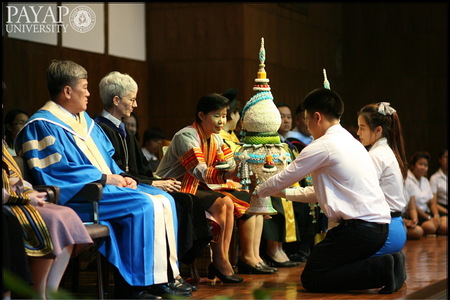|
On a selected Thursday early in the academic year every educational institution in Thailand will have a “wai kru” ceremony so that students may pay respect to their teachers. Teachers are generally accepted as “second parents” to students, and schools are a “second home”. Schools and teachers are invested with a great level of trust in Thai society.
First, a discussion of terms. “Wai” is a gesture with the hands, palms together, in front of one’s chest, chin, face or with the knuckles of the thumbs touching ones forehead. The gesture is both a common greeting and an implied exchange of respect with a touch of reverence. A wai is fraught with meaning. The way it is carried out signals recognition of social status. It may happen in a flash, but the two persons will catch a sense of who is who from that first moment. To wai is to show respect or reverence toward something or someone. [Perhaps I will expand on this in a future essay.] “Kru” (or khru) means “teacher”. The word is pronounced like the English word “crew”. As a common noun kru refers to a role. In spoken Thai the word may precede the teacher’s name, and so serve as a title. It is not only proper to refer to a teacher as “Kru so-and-so” or simply as Khun Kru (“Mistress Teacher” or “Mister Teacher”), it is highly improper not to attach the title. Since there is no such formality in English (except in some places the word “Professor”, as every Harry Potter fan knows), Americans in Thai classrooms may find it grates on the ear to be greeted , “Good morning, teacher”, and “Thank you, teacher”. For those with college degrees or who are experts in some field and who function as teachers, the word “acharn” (now spelled “ajan”) takes the place of kru as a title. The typical wai kru ceremony involves two actions undertaken by the students: presentation of a traditional flower arrangement, and recitation of expressions of respect. In the picture accompanying this essay, students at Payap University are presenting floral tributes to the president of the university. All the faculty members are understood to be honored simultaneously. Each of the university’s colleges and faculties selects students to make a presentation in turn. At a primary or secondary school each homeroom will make such a flower arrangement for wan wai kru, the day to pay homage to teachers (not to be confused with “teachers day” which is a school holiday in January). These flower arrangements constructed of buds, petals and leaves attached to a clay or Styrofoam core on a pedestal tray also include candles and incense sticks. The arrangement should include four items: (1) dawk khem (ixora) flowers with pointed buds representing sharp wit, (2) yaa phraek (Cynodon dactylon) grass known to grow fast and be hardy, thereby symbolizing perseverance and ability to learn, (3) popped rice which symbolizes discipline, (4) and eggplant flowers which bow low when near the fruit stage, and symbolize respect and humility. A very great deal of creativity goes into constructing these arrangements. Sometimes prizes are awarded for various categories of art or significance. As for the “expressions of respect” or homage, generally a student recites a poem extolling the virtues of the teachers and the gratitude of the students. If at all possible, however, the students will have learned the Sarabhanna chant, that was written by Thanpuying Dussadee Malakul Na Ayutthaya in 1941 for a Wai Kru ceremony at Trium Udom School. That ceremony has become the model for almost all teacher veneration ceremonies. The president or head of the institution will thank the students for doing this, and probably offer advice on being a good student. There may be other presentations of dances or musical numbers, but the ceremony is usually not long. Aside from general education, teacher veneration ceremonies are observed in three disciplines: drama, massage and martial arts. A study of these ceremonies shows how the tradition goes back to Vedic times with even earlier origins in supernaturalism (also called “animism”). Fifty years ago Ajan Dhanit Yupho described the wai kru ceremony for students and masters of the dramatic/musical arts of khon (classical masked dance) and lakon. Similar rites are performed for likay (folk melodrama) and pipat (musical ensembles that include gong circles and xylophones, used to accompany the dramas). In these wai kru ceremonies the Rishi Bharotmuni, whom Aj Dhanit calls “the prime teacher of dramatic art”, and all other subsequent teachers right up to the present generation, are honored. “Invitation” chants, Aj Dhanit explains, call on “gods of the drama and spirits of departed teachers” to come and accept offerings of bai sri (featured in another essay in this series, and in paragraph two above), liquor, rice, a hog’s head, duck, chicken, etc. “Pupils twice make three traditional obeisances. The presiding teacher orders the scattering of popped rice which is then sprinkled thrice.... Each pupil then takes a sip of the wash-water from the taphon which is also used to wet the pupil’s hair by the presiding teacher.” That is followed by a recital of traditional music according to a formula set by HM King Rama IV (1851-1868). [See Dhanit Yupho, 2507 (1964), The Custom and Rite of Paying Homage to Teachers of Khon, Lakon and Piphat. Bangkok, The Fine Arts Department.] The wai kru ceremony is one of the best examples of how overlapping traditions from all four Thai faith domains are combined: religion, spirituality, venerations and supernaturalism. The resilience of Thai culture comes from this complex plaiting of strands of faith. At the same time, religious co-existence and mutual respect make allowances for adapting ceremonies by which homage is paid to teachers, within different religious communities.
0 Comments
Leave a Reply. |
AuthorRev. Dr. Kenneth Dobson posts his weekly reflections on this blog. Archives
March 2024
Categories |
| Ken Dobson's Queer Ruminations from Thailand |
|

 RSS Feed
RSS Feed
